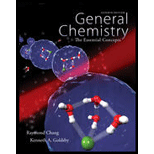
Concept explainers
(a)
Interpretation: The neutron numbers should be predicted for the given neutron–rich isotope
Concept Introduction:
Conversion of atoms to moles:
Nuclear stability: The nucleus is composed of protons and neutrons. The strongest nuclear force binds the particles tightly. Though the protons repel each other due to no attraction between similar charges, possess short-range attractions made the attraction possible between proton and proton, proton and neutron, neutron and neutron.
The stability of any element is determined by the difference between coulombic repulsion and the short-range attraction. If repulsion outweighs the attraction, the disintegration of nucleus occurs by producing the daughter nuclides. If the attractive forces prevail, the nucleus is stable.
(a)
Answer to Problem 2.64QP
Explanation of Solution
Predict the neutron numbers in the
(b)
Interpretation: The neutron numbers should be predicted for the given neutron–rich isotope
Concept Introduction:
Conversion of atoms to moles:
Nuclear stability: The nucleus is composed of protons and neutrons. The strongest nuclear force binds the particles tightly. Though the protons repel each other due to no attraction between similar charges, possess short-range attractions made the attraction possible between proton and proton, proton and neutron, neutron and neutron.
The stability of any element is determined by the difference between coulombic repulsion and the short-range attraction. If repulsion outweighs the attraction, the disintegration of nucleus occurs by producing the daughter nuclides. If the attractive forces prevail, the nucleus is stable.
(b)
Answer to Problem 2.64QP
Explanation of Solution
Predict the neutron numbers in the
(c)
Interpretation: The neutron numbers should be predicted for the given neutron–rich isotope
Concept Introduction:
Conversion of atoms to moles:
Nuclear stability: The nucleus is composed of protons and neutrons. The strongest nuclear force binds the particles tightly. Though the protons repel each other due to no attraction between similar charges, possess short-range attractions made the attraction possible between proton and proton, proton and neutron, neutron and neutron.
The stability of any element is determined by the difference between coulombic repulsion and the short-range attraction. If repulsion outweighs the attraction, the disintegration of nucleus occurs by producing the daughter nuclides. If the attractive forces prevail, the nucleus is stable.
(c)
Answer to Problem 2.64QP
Explanation of Solution
Predict the neutron numbers in the
(d)
Interpretation: The neutron numbers should be predicted for the given neutron–rich isotope
Concept Introduction:
Conversion of atoms to moles:
Nuclear stability: The nucleus is composed of protons and neutrons. The strongest nuclear force binds the particles tightly. Though the protons repel each other due to no attraction between similar charges, possess short-range attractions made the attraction possible between proton and proton, proton and neutron, neutron and neutron.
The stability of any element is determined by the difference between coulombic repulsion and the short-range attraction. If repulsion outweighs the attraction, the disintegration of nucleus occurs by producing the daughter nuclides. If the attractive forces prevail, the nucleus is stable.
(d)
Answer to Problem 2.64QP
Explanation of Solution
Predict the neutron numbers in the
Want to see more full solutions like this?
Chapter 2 Solutions
General Chemistry
 ChemistryChemistryISBN:9781305957404Author:Steven S. Zumdahl, Susan A. Zumdahl, Donald J. DeCostePublisher:Cengage Learning
ChemistryChemistryISBN:9781305957404Author:Steven S. Zumdahl, Susan A. Zumdahl, Donald J. DeCostePublisher:Cengage Learning ChemistryChemistryISBN:9781259911156Author:Raymond Chang Dr., Jason Overby ProfessorPublisher:McGraw-Hill Education
ChemistryChemistryISBN:9781259911156Author:Raymond Chang Dr., Jason Overby ProfessorPublisher:McGraw-Hill Education Principles of Instrumental AnalysisChemistryISBN:9781305577213Author:Douglas A. Skoog, F. James Holler, Stanley R. CrouchPublisher:Cengage Learning
Principles of Instrumental AnalysisChemistryISBN:9781305577213Author:Douglas A. Skoog, F. James Holler, Stanley R. CrouchPublisher:Cengage Learning Organic ChemistryChemistryISBN:9780078021558Author:Janice Gorzynski Smith Dr.Publisher:McGraw-Hill Education
Organic ChemistryChemistryISBN:9780078021558Author:Janice Gorzynski Smith Dr.Publisher:McGraw-Hill Education Chemistry: Principles and ReactionsChemistryISBN:9781305079373Author:William L. Masterton, Cecile N. HurleyPublisher:Cengage Learning
Chemistry: Principles and ReactionsChemistryISBN:9781305079373Author:William L. Masterton, Cecile N. HurleyPublisher:Cengage Learning Elementary Principles of Chemical Processes, Bind...ChemistryISBN:9781118431221Author:Richard M. Felder, Ronald W. Rousseau, Lisa G. BullardPublisher:WILEY
Elementary Principles of Chemical Processes, Bind...ChemistryISBN:9781118431221Author:Richard M. Felder, Ronald W. Rousseau, Lisa G. BullardPublisher:WILEY





